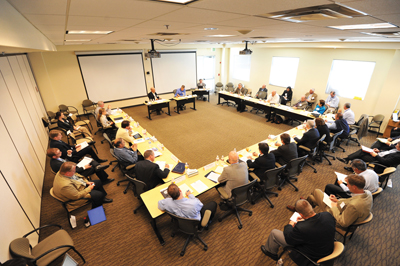
New Mexicans think of water problems in terms of scarcity and drought. But a collection of 21 experts convened, at the behest of the White House, at Sandia in late September showed that these problems were only, so to speak, the trunk of the elephant.
Frank discussions among normally stovepiped participants — ranging from high-tech and manufacturing industries to water associations, universities, and local and state government water boards — may stimulate preparation of a roadmap that could guide the federal government in supporting sustainable, “smart-water” communities.
Just the term “smart water” drew fire from several participants. Analogizing it to “smart power grid” metering, Lester Snow from the California Water Service Group said, “The energy-water analogy is great when looked at from 50,000 feet [up], but breaks down when you look at the subject more closely.
“Water rights are much more prevalent than energy rights. Water is cheap and it’s private property,” he said. “This leads to the ‘classic tragedy of the commons.’
That is, individuals pump the water, but if something happens, it’s the community’s problem.”
Another participant called the nation’s water supplies “a fragmented system with a thousand variations.”
A water resources engineer said that while many factors played a role, “the gorilla in the room is social/economic issues: Who owns the water, what they can do with it, and how it can be made available to new uses.”
Others mentioned the value that could be added by new technologies, if developed and purchased, in tracking water flow and purity from reservoir to tap. Also of value would be weather forecasting and satellite observations that determine and predict the current and future state of mountain snow banks.
Several participants mentioned the enormous amount of water — perhaps as much as 40 percent — leaked from reservoir to tap in many cities from cracks in huge underground pipes. Laid fifty to seventy-five years ago, some have exceeded their expected lifetimes. “Mayors have their eyes above ground for votes,” one participant said. “What’s below the ground is easily ignored unless there’s a disaster.”
The roundtable discussion energized Sandia VP 8000 Rick Stulen, who co-hosted the meeting with National Institute of Standards (NIST) Director Pat Gallagher.
“The place of a national laboratory is to bring people together to work out solutions to national problems,” said Rick after the meeting. “Sandia’s interest is water security, but that resonates with other water problems.”
Expanding the discussion of wastewater treatment and fresh water supply into international terms, Christine Landavazo, a staffer for Senator Jeff Bingaman, said that she had been in discussions with a number of Israeli companies that have been producing innovations for their water-starved nation for the last 50 years.
“They’re amazed at how much water our systems waste,” she said. Better technologies are out there, she said, but companies need national demand to make marketing them here feasible.
Gallagher spelled out the roles of relevant federal agencies like this: the Environmental Protection Agency regulates water use; DOE is interested in water but only for energy; and NIST could serve as a kind of go-between for government and industry.
Said Gallagher, “The normal way things happen in government is that a bunch of feds get together and say, ‘Wouldn’t it be great if . . . ?’ They dangle some money for proposals and people run around with their hair on fire coming up with ideas. But wouldn’t it be great if people came together and said, on their own, ‘We could catalyze the following things.’ You have the opportunity to be the North Star, to help form the road to travel.
“Regulations are inevitable. If we don’t set our own, international standards will be imposed and we’ll be operating reactively. For NIST to be helpful, we need an organized voice from your community. A roadmap is the result of companies and individuals working together. We have the vehicle to help the group form and support it, but you’re going to need to be the driver.”
A closed blog available to participants and certain meeting observers will enable participants to continue their discussion from afar.
Preparations for the meeting were achieved by a planning committee led by Rob Leland. Helping were Sandhya Rajan, John Merson, Erick Ridley, Bob Hwang, Tara Camacho-Lopez, and others.